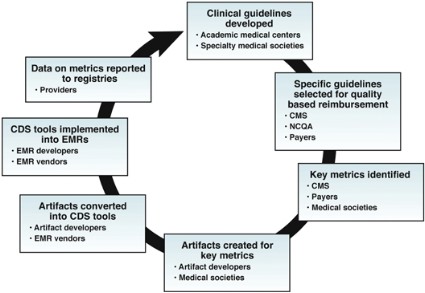It is difficult to imagine that practice guidelines, randomized controlled trials, evidence-based medicine, and similar tools of current practice did not exist a generation ago. We now have a rich repository of guidelines, and with the advent of electronic health records, they can be translated into patient care through the use of clinical decision support tools. The AGA understood the importance of its leadership in this area and organized development of such tools within its "Roadmap to the Future of GI Practice." In this month’s Practice Management section, Dr Lawrence R. Kosinski, an expert in the field of clinical decision support, shares some of his insights into this segment of The Roadmap.
John I. Allen, MD, MBA, AGAF Special Section Editor
"First we build the tools, then they build us"
Marshall McLuhan
Introduction
The field of Information Technology has become imbedded within the practice of medicine. As a result, aspects of our profession that traditionally have been the sole province of human intelligence are now performed by computers with greater precision and at a vastly greater scale and speed. Indeed, this process is already well under way. Every time you send an e-mail or connect a cell phone call, intelligent algorithms optimally route the information. They also automatically detect credit card fraud, fly and land airplanes, guide intelligent weapons systems, assemble products in robotic factories and play games such as chess, routinely defeating humans. We are building tremendous tools and they are now increasing what we can accomplish.
The rise in the use of health care information technology has also come at a very critical point for our profession as the rising cost of health care is no longer sustainable Those who are at risk for the payment of our services are no longer willing to bear it alone and are altering the structure of our health care system so as to transfer the financial risk on to us the providers. Accordingly, providers are going to be responsible for not only the provision of care but also for its quality and expense. To lower our cost and handle the risk of care, we as providers must fulfill the following objectives:
1. Assure that each health care professional is working up to the level of his/her licensure.
2. Facilitate the provision of care down to the lowest level professional capable of providing it.
3. Limit the scope of lower level professionals so that they are able to work at maximum levels.
4. Establish better system-wide communication so that this is all possible.
5. Report all outcomes data to external repositories and registries.
Electronic health records (EHRs) will be essential to accomplishing these objectives, but not without substantial change. The EHR of the future will not be the silo’d version we use today, but rather one whose user interface (UI) is tailored to the clinical experience and whose database is tied to a health information exchange (HIE) that is integrated with multiple outcomes registries.
The UI will derive much of its strength and power from judicious use of Clinical Decision Support (CDS) tools: information technology artifacts that create a process for enhancing health-related decisions and actions with pertinent, organized clinical knowledge and patient information, to improve health and healthare delivery.
CDS tools
Most of us are very accustomed to decision support tools like GPS devices that tell us where we are and Internet search engines that help us make choices. CDS tools in health care are the same type of devices but they help us practice higher quality Medicine. We see them regularly as drug-drug Interactions, drug-allergy interactions and dose range checking. Those who have implemented EMRs are utilizing them for orders with standardized evidence-based ordersets and have implemented standardized system-based policies.
The Centers for Medicare and Medicaid Services (CMS) describe CDS tools as "health information technology functionality that builds upon the foundation of an EHR to provide persons involved in care processes with general and person-specific information, intelligently filtered and organized, at appropriate times, to enhance health and health care."
The 2012 Institute of Medicine (IOM) Report, Best Care at Lower Cost: The Path to Continuously Learning Health Care in America makes recommendations for CDS tools. Their third recommendations states: "Accelerate integration of the best clinical knowledge into care decisions. Decision support tools and knowledge management systems should be routine features of health care delivery to ensure that decisions made by clinicians and patients are informed by current best evidence."
These IOM recommendations reflect the value of CDS tools as they: improve quality, maintain safety and decrease cost. Outcomes are also improved by CDS as they:



